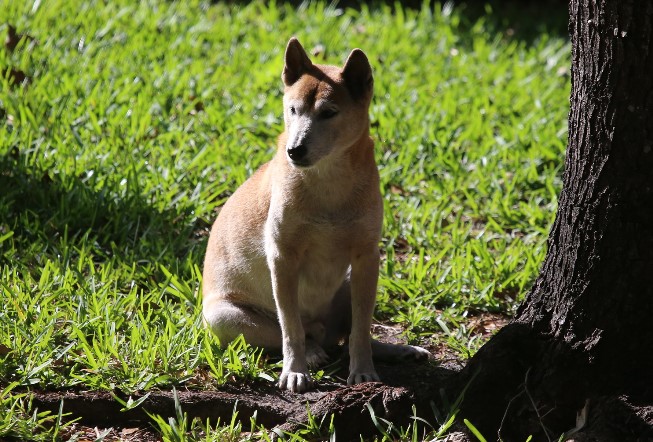All of the many diverse breeds of dogs, including both domestic and wild dogs (wolves, coyotes, foxes, jackals, and dingoes), belong to the genus Canis in the mammalian family Canidae. One intriguing example of an obscure wild dog is the New Guinea singing dog (also referred to as the New Guinea Highland dog), which is named after its native location and unique songlike vocalizations (which resemble the howls of wolves, but with harmonic overtones similar to those of humpback-whale songs). Related to the Australian dingo, the New Guinea singing dog had been presumed to be extinct in the wild, with extant members (about 200 to 300 individuals in total) being held in conservation centers and zoos, as well as some being kept by humans as unusual pets. However, investigations were initiated after a rare sighting of a possible singing dog in the wild in 2012. Subsequently, further research efforts, including a more in-depth survey of the New Guinea Highlands beginning in 2016 and a genetic analysis of DNA from two trapped wild singing dogs and a dead one in 2018, have determined that the elusive New Guinea singing dog is indeed roaming the highlands of New Guinea. See also: Animal breeding; Deoxyribonucleic acid (DNA); Dogs; East Indies; Endangered species; Extinction; Genetics; Mammalia

Prior to the 2012 sighting and 2016 survey of the New Guinea Highlands, the last known glimpse of a New Guinea singing dog in the wild occurred in the 1950s. As no other contrary evidence was forthcoming in those intervening decades to indicate the continued existence of the singing dog in the wild, scientists assumed that its wild population was extinct. However, the remote location and extreme altitude [more than 4000 m (13,120 ft) high] of the New Guinea Highlands hinder easy access, and financial constraints and the needs to address other pressing conservation concerns prevented any investigative expeditions to study the status of the singing dogs in the wild. As such, it was the lack of opportunity and accessibility that prevented a more-thorough examination of the highland region. See also: Conservation of species
Research efforts conducted since 2016 have provided solid evidence of the existence of New Guinea singing dogs in the wild. Since 2016, investigators have reported more than 150 sightings of singing dogs in the Highlands, and at least 15 dogs have been identified individually in the wild. Moreover, these efforts have furnished substantial information concerning the possible provenance of New Guinea singing dogs and the genealogical (phylogenetic) history of dingoes and New Guinea singing dogs. Genetic evidence derived from the aforementioned wild singing dogs that were trapped in 2018, as well as from the additional dead specimen, indicate that those dogs are part of the direct lineage of the original New Guinea singing dog population. Genetic analyses also determined that the genomes of the wild dog population were not derived from captive singing dogs that had escaped their confines and returned to a wild state. In fact, the wild dogs possessed much greater genetic variation compared to captive individuals, which would be generally expected for wild populations (as opposed to domestic, inbred populations that show less genetic diversity). Furthermore, genetic similarities among dingoes and New Guinea singing dogs suggest a common ancestor that lived about 8000 years ago. At that time, the mean sea level was lower, and Australia and New Guinea formed a single landmass. The ancestral population of dingoes and New Guinea singing dogs lived on this landmass. However, when the mean sea level rose, the single landmass became separated by oceanic waters into two smaller landmasses (Australia and New Guinea), and the ancestral population subsequently split into the present-day dingoes and New Guinea singing dogs. See also: Dog domestication; Genomics; Phylogeny; Speciation





